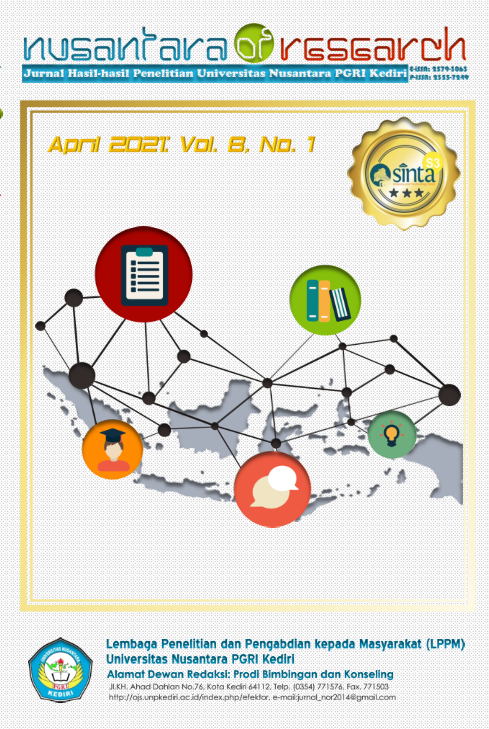The Effectiveness of Peer Counseling Increase Adolescent Resilience in The Pondok Pesantren Bahrul Ulum Jombang
Main Article Content
Abstract
This research is based on phenomena that occur in the field that indicate attitudes and behaviors that lead to resilience or fighting power of pesantren adolescents. The purpose of this study was to increase the resilience of pesantren adolescents through peer counseling. The research design used a pretest-posttest control group design. There are two types of instruments used, namely treatment and measurement instruments. The treatment instrument consisted of a peer counseling guidebook, while the measurement instrument consisted of a resilience scale with a validity of 0.320 and a reliability of 0.855 and a student self-reflection sheet. Data analysis used the Two-Independent-Sample Test-Mann-Whitney U test. The results of statistical analysis showed that the calculated z value> z table is -3.315 and the Asymp value. Sig. (2-tailed) is 0.001 <0.05, then H0 is rejected. This means that peer counseling is effective in increasing the resilience of pesantren adolescents
Downloads
Article Details
Issue
Section
Authors who publish with this journal agree to the following terms:
- Copyright on any article is retained by the author(s).
- The author grants the journal, the right of first publication with the work simultaneously licensed under a Creative Commons Attribution License that allows others to share the work with an acknowledgment of the work’s authorship and initial publication in this journal.
- Authors are able to enter into separate, additional contractual arrangements for the non-exclusive distribution of the journal’s published version of the work (e.g., post it to an institutional repository or publish it in a book), with an acknowledgment of its initial publication in this journal.
- Authors are permitted and encouraged to post their work online (e.g., in institutional repositories or on their website) prior to and during the submission process, as it can lead to productive exchanges, as well as earlier and greater citation of published work.
- The article and any associated published material is distributed under the Creative Commons Attribution-ShareAlike 4.0 International License
How to Cite
References
Astiti, P. S. (2019). Efektivitas Konseling Sebaya (Peer Counseling) dalam Menuntaskan Masalah Siswa. Indonesian Journal of Islamic Psychology, 1(2), 243–263.
Borg, W. R. (1983). dan Gall, MD. Educational Research, An Introduction, 113.
Ekasari, A., & Yuliyana, S. (2012). Kontrol diri dan dukungan teman sebaya dengan coping stress pada remaja. Jurnal Soul, 5(2), 55–66.
Fatnar, V. N., & Anam, C. (2014). Kemampuan interaksi sosial antara remaja yang tinggal di pondok pesantren dengan yang tinggal bersama keluarga. Jurnal Fakultas Psikologi, 2(2), 71–75.
Fergus,S. & Zimmerman, M. . (2005). Adolescent resilience: A framework for understanding healthy development in the face of risk. Annual Review of Public Health, 26, 399–419.
Grotberg, E. H. (1995). A Guide to Promoting Resilience in Children : Strengthening the Human Spirit. Bernard van Leer Foundation.
Hadianti, W. Salsabila., Nurwati, N., & Darwis, S. R. (2017). Resiliensi remaja berprestasi dengan latar belakang orang tua bercerai. Prosiding Penelitian Dan Pengabdian Kepada Masyaraka, 129–389.
Hasanah, N., & Rusmawati, D. (2020). Hubungan Antara Resiliensi Dengan Kematangan Karir Pada Remaja Penyandang Disabilitas Daksa Prof. Dr. Soeharso Surakarta. Jurnal EMPATI, 7(3), 1119–1123.
Lerner, RM. & Galambos, N. (1998). Adolescent dev elopment: challenges and opportunities for research, program and policies. Annual Review of Psychology, 49, 413–446.
Putri, D., & Rusli, D. (2020). Pengaruh Dukungan Teman Sebaya Terhadap Resiliensi Remaja Pesantren Modern Nurul Ikhlas. Jurnal Riset Psikologi, 1(1), 1–12.
Reivich, K., & Shatte, A. (2002). The Resilince Factor 7 Essential Skill for Overcoming Life’s Inevitable Obstacle. Random House, Inc.
Reivich, K. dan Shatte, A. (2020). The Resiliency Factor : 7 Keys to Finding Your Inner Strength and Overcoming Life’s Hurdles. In Three Rivers Press (Vol. 57). Three Rivers Press.
Santoso, S. (2003). Mengatasi Berbagai Masalah dengan SPSS Versi 12. PT Elex Media Komputindo.
Siebert, A. (2005). The Resiliency Advantage. Practical Psychology Press.
Steinhardt, M., & Dolbier, C. (2008). Evaluation of a Resilience Intervention to Enhance Coping Strategies and Protective Factors and Decrease Symptomatolog. Journal of American College Health, 56(4), 445–533.
Uyanto, S. S. (2009). Pedoman Anlisis Data dengan SPSS. Graha Ilmu.
Winfield, & L. F. (1994). Developing resilience in urban youth. Urban monograph series. US: North Central Regional Educational Laboratory.




